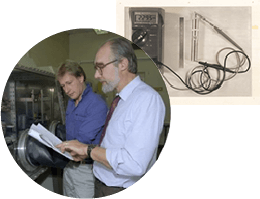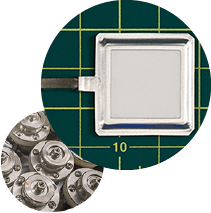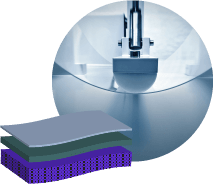+
Leading
the field in
battery
innovation.
-
PolyPlus is among the world leaders in the development of next-generation battery technology.
The invention of the PLE by PolyPlus scientists allowed the company to pioneer a number of ultra-high energy density chemistries that were previously considered to be impractical or impossible, including Li-Air, Li-Seawater, and aqueous Li-S batteries. The invention of the solid-state lithium glass laminate represents an even larger step by enabling a new generation of rechargeable lithium batteries with twice the energy density of Li-ion batteries.
History

1991
PolyPlus is founded upon the invention of the lithium/organosulfur battery at the Lawrence Berkeley National Laboratory.

2000
PolyPlus invents & patents the protected lithium electrode (PLE™).

2011
PolyPlus develops the first water-activated lithium battery. TIME Magazine names it a 50 Best Inventions of 2011.

2017
PolyPlus introduces glass protected Li metal batteries. A major innovation in lithium anodes.
Founded upon the invention of a lithium/organosulfur battery at the Lawrence Berkeley National Laboratory, PolyPlus has been in continuous operation since 1991. PolyPlus’ early business model was focused on IP development and licensing. These roots yielded a company culture that combines scientific creativity with disciplined execution, as well as a comprehensive intellectual property portfolio. Over the years, PolyPlus has been supported by a combination of funding from licensing, private investment, industry, and government contracts from the Department of Energy and the Department of Defense.
PolyPlus invented and patented the protected lithium electrode (PLE™), a core technology that enables the use of ultra-light metallic lithium anodes in batteries. PolyPlus has used the PLE concept to develop both primary and rechargeable batteries with lithium metal anodes. PolyPlus’ inventions include non-aqueous lithium/sulfur batteries, primary lithium-water, primary and rechargeable lithium-air, and rechargeable aqueous lithium-sulfur batteries.
PolyPlus currently has 18 employees (14 technical and 4 administrative/facilities). PolyPlus has a well-equipped R&D facility in a 13,000 ft2 building in Berkeley, CA. In 2013, PolyPlus installed a semi-automated pilot line to produce PLEs.
Intellectual Property
PolyPlus’ extensive patent portfolio includes fundamental claims on the subject of protected lithium electrodes (PLEs). The PLE™ is a core element of the PolyPlus portfolio because it represents a major advancement in battery technology: the PLE™ enables the safe use of high energy density lithium metal anodes in batteries.
PolyPlus’ portfolio also covers key aspects of various liquid and solid electrolytes, and advanced battery chemistries including Lithium Air, Lithium Seawater, and Lithium Sulfur systems. In addition to discovery phase research, PolyPlus develops battery structures, seals and associated hardware necessary to maximize the performance of its unique chemistries. Currently, PolyPlus Battery Company holds more than 200 issued patents and pending patent applications.
Facilities
The PolyPlus facilities, located in Berkeley, CA, have state of the art equipment and capabilities for battery research and development, including:
- Semi-automated pilot line for the fabrication of its PLEs. This one of a kind multi-station pilot line was designed by PolyPlus engineers and built by a premiere lithium ion battery equipment manufacturer.
- Dry room facility for lithium handling, electrode fabrication and battery assembly. The dry room facility is interconnected to a network of state of the art argon filled gloveboxes.
- State of the art electrochemical and battery cell testing equipment, including several 100-channel Maccor battery testers, as well as potentiostat/galvanostat systems with impedance spectroscopy channels for electrochemical analysis.
- A network of double and triple workstation gloveboxes operating at below 1 ppm moisture and 1 ppm oxygen levels.
- Scanning electron microscope equipped with EDAX and optical microscopy, including a digital 3-D surface profiling high magnification Keyence microscope.
- Automated porosimetry apparatus that non-destructively measures pore-size distribution in materials and engineered structures over a very wide range of pore sizes (1 nanometer to 300 microns).

